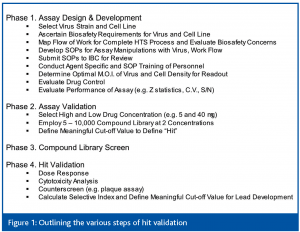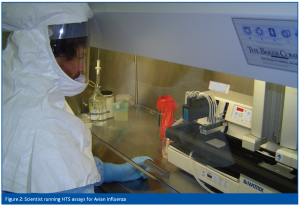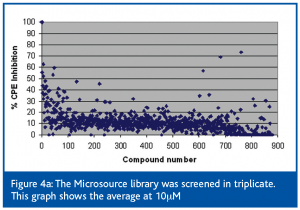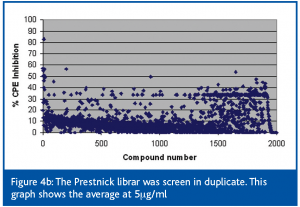Pursuing hot targets in drug discovery
Posted: 28 November 2006 | | No comments yet
Over the past few decades we have experienced a dramatic increase in the rate of emergence and re-emergence of infectious diseases1,2. Many of these diseases, such as SARS, resulted in fewer than 1,000 deaths, but caused an estimated 2 per cent decline gross domestic product in East Asia. The economic impact of a pandemic influenza outbreak could result in the loss of millions of lives and cost an estimated 900 billion (US).
Over the past few decades we have experienced a dramatic increase in the rate of emergence and re-emergence of infectious diseases1,2. Many of these diseases, such as SARS, resulted in fewer than 1,000 deaths, but caused an estimated 2 per cent decline gross domestic product in East Asia. The economic impact of a pandemic influenza outbreak could result in the loss of millions of lives and cost an estimated 900 billion (US).
Over the past few decades we have experienced a dramatic increase in the rate of emergence and re-emergence of infectious diseases1,2. Many of these diseases, such as SARS, resulted in fewer than 1,000 deaths, but caused an estimated 2 per cent decline gross domestic product in East Asia. The economic impact of a pandemic influenza outbreak could result in the loss of millions of lives and cost an estimated 900 billion (US).
In addition to the natural emergence of previously unrecognised pathogens, we have observed the purposeful release of anthrax in 2001. This act of bioterrorism also impacted regional economics and resulted in an enormous restructuring of science practices and regulatory policies in the United States, particularly with the use of select agents. In the last decade, resources have become available for the development of facilities to study these pathogens and, importantly, toward the development of therapeutics for the treatment of the diseases they inflict. The following article will provide a brief introduction to these agents and the special considerations that must be taken into account to develop a program focused on drug discovery for these pathogens. An example of one of the virology HTS programs developed at Southern Research, SARS CoV, will also be outlined.
The NIH and CDC have three categories for these classes of pathogens; A, B and C3,4. These agencies have grouped them by how easily they can be spread and the severity of the disease that they cause. For example, many of the hemorrhagic fever viruses such as Ebola, Machupo and Hantaan viruses and the bacterium Bacillus anthracis (anthrax), are placed in Category A because they are considered to have the highest risk and impact in spread and illness. Nipah virus, influenza, severe acute respiratory distress syndrome coronavirus (SARS CoV) and additional hantaviruses are grouped as Category C agents, since they are considered emerging infectious disease threats. In addition to the basic research efforts needed to understand the life cycles of these pathogens and their effect on human or wildlife hosts, it is essential that we begin to develop therapeutics for treatment of their diseases. The vast majority of these agents require specialised containment laboratories referred to as Biosafety Level 3 or 4 (BSL3/4) Laboratories5. There are several major issues that one must consider to establish a facility dedicated to the discovery and development of new therapeutics; the requirement for BSL3 or 4 laboratory facilities; regulatory issues (e.g. Select Agent Rule6, GLP compliance, CDC and USDA permits); personal protective equipment (PPE) and containment of equipment as necessary. In addition, the processes for flow of work among the various laboratories must be thoroughly reviewed to ensure high quality results. The overall approach to implementation of high-throughput screening (HTS) for a BSL3 pathogen, SARS CoV7,8, is discussed here.
Phase 1: Assay design & development
The first HTS assay we implemented at Southern Research Institute (Southern Research) was for the SARS CoV. The luminescent-based assay measures the inhibition of SARS CoV-induced cytopathic effect (CPE) in Vero E6 cells. Figure 1 outlines the various steps undertaken through hit validation.
The first step in the process was a risk assessment of the pathogen with respect to its transmissibility and the type of containment required within the BSL3 (Figure 1). Hence, prior to the development of the screen, decisions were made on the type of PPE to be worked by laboratory workers and type of containment required for equipment that might aerosolise the virus. The coronaviruses (order Nidovirales – family Coronaviridae – genus Coronavirus) are members of a family of positive-sense RNA viruses that replicate in the cytoplasm of animal host cells. They are a diverse group of large, enveloped viruses that infect many mammalian and avian species causing upper respiratory, gastrointestinal, hepatic and central nervous system diseases. It is generally accepted that SARS CoV is transmitted by close person-to-person contact through coughing or sneezing that deposits respiratory droplets on the mucous membranes of the mouth, nose or eyes of persons nearby. Additionally, transmission can occur through contact with surfaces contaminated with the infectious droplets. Because SARS CoV is airborne and has the ability to be transmitted from person to person, it was decided that persons handling the virus would wear PAPRs or positive air pressure respirators, full-length Tyvek suits with a wrap-around gown over the scrubs, double shoe covers and double latex gloves (Figure 2). The wrap-around gown and additional layer of gloves and shoe covers are put on before entering the HTS laboratory within the BSL3 and removed when exiting the HTS laboratory. It was decided that the Biomek equipment that dispenses the virus into drugged plates would be placed inside a biosafety cabinet (BSC). However, the Envision reader for reading the endpoints was kept outside. The Envision reader has a plate stacker and while there is inherent risk of plates dropping or getting jammed into the reader, it was decided that the PPE and BSL3 would act as sufficient barriers to any possible accidental exposure.
Once the protective barriers were in place, the next step in establishment of the screen was to define the optimal flow of work (Figure 3). While it would be advantageous to add chemical compounds to the screen after virus addition, the problems associated with maintaining compound libraries in the BSL3 would be formidable. In addition, due to BSL3 regulations, compounds could not leave the facility without undergoing a decontamination procedure, which could prevent evaluation of compounds after a study’s completion. We agreed that storage and aliquoting of compounds would take place 24 hours after the addition of cells to microtiter plates. All of the processes, procedures and safety considerations were submitted to the Institutional Biosafety Committee for review.
Once approval was met, we embarked upon the actual development and optimisation of the assay as well as evaluation of the flow of work outlined.
Findings for the SARS CoV HTS assay
For cell addition, we found that plating Vero E6 cells in black, clear-bottomed, 96-well plates at a density of 10,000 cells/well in 50 μl assay medium, using a Titertek Multidrop 384, was optimal following a titration of cells. We incubate for 24 hours at 37°C, 5 per cent CO2 with high humidity. We have found that the Titertek Multidrop is excellent for handling live cells. We have also found that special attention must be paid to controlling the humidity of the CO2 incubator and some brands appear to do this better than others. The following day 25 μl of compounds are added to cells using a Beckman Coulter Biomek FX. In our work flow, plates are drugged and then hand carried into the BSL3 in groups of 50 plates per run. We have found that using more than 50 plates proves difficult in the BSL3 environment simply because of movement logistics. In the BSL2 HTS Virology laboratory, however, we can move up to 125 plates quite effectively. Plating of the compounds requires approximately twice as much time as plating of the virus, so the flow of work depends on the equipment chosen for this activity.
After three days of incubating Promega Cell Titer Glo was added to each well using the Biomek 2000. We have recently switched from the Biomek to the Wellmate by Matrix, which has a smaller footprint. Smaller footprints in equipment are of great advantage in BSL3 where space in a premium. For 96 microtiter plate assays, plates are shaken on a Labline Instruments plate shaker, which also serves the small footprint idea. For 384 plates, we do not rock the plates. Luminescence is measured using a Perkin Elmer Envision plate reader. An Ethernet interface allows direct uploading of the data into our database and analyses using Activity Base software (IDBS, Inc) outside of the BSL3. Each plate contains negative and positive controls that are used to fail or pass plates that have Z values of less than 0.59.
Phase 2: Assay validation
As part of the validation for this assay, two small compound libraries were screened to determine the reproducibility of the ‘hits’ and the ‘hit’ rate. A ‘hit’ is identified as an active compound that either activates or inhibits the assay signal above a defined threshold value from the sample mean signal. A ‘hit’ for this assay was considered to be any compound exhibiting a % CPE inhibition of >50%. The Microsource library was screened in triplicate and the average at 10 μM is shown (Figure 4A). The Prestwick library was screened in duplicate and the average at 5 μg/ml is shown (Figure 4B). The ‘hit’ rate for both libraries was determined to be approximately 0.01%. While we did not validate our library in this study against a high and low drug concentration, our subsequent studies with other viruses have shown this to be an important step at this stage of assay validation.
Phase 3 and 4: Compound library screen and hit validation
Following this stage, we were ready to screen our large library. We screened 100,000 compounds in duplicate from the NINDS compound library against SARS CoV using the validated HTS assay. The hit rate for the library (compounds that inhibited CPE by > 50%) in a single dose (SD) format was determined to be approximately 0.8%. To screen selected hits from the SD assay, compounds were confirmed in a DR format. Furthermore, an assay was employed to determine the point in the SARS CoV lifecycle that the DR hits inhibited. In effect this simple screen allowed us to ascertain whether the inhibition of the compound was early (entry) versus late (replication). In this screen compounds were added to cells six hours after infection with SARS CoV. The assay was executed for 77 of the DR hits from the NINDS library. The criteria for determining compound activity are based on its selective index (SI50). We classify the compounds with SI50 value of <4 as not active, SI50 = 4-9, as slightly active, SI50 = 10-49 as moderately active and an SI50 value >50 as highly active. Forty eight of the seventy-seven compounds were slightly active, twenty-five were moderately active and three were highly active.
Summary
At present, we know of no antiviral drugs approved by the US Food and Drug Administration for treatment of any of the hemorrhagic fever viruses (HFV) and the majority of the newly emerging viruses. And while there are FDA-approved drugs available for treatment of the more common pathogens such as flu, they have limited efficacy. We hope that the infrastructure and procedures we have implemented will lead to the discovery of new antiviral drugs for these important emerging and re-emerging pathogens.










References
- Satcher, 1995, Emerg. Inf. Dis. 1:1-6.
- King et al., 2006 Science 313:1392-3.
- http://www.bt.cdc.gov/agent/agentlist-category.asp
- http://www3.niaid.nih.gov/biodefense/bandc_priority.htm
- http://www.cdc.gov/OD/OHS/biosfty/bmbl4/bmbl4toc.htm
- http://www.cdc.gov/od/sap/
- Peiris JS,et al., 2003. Lancet 361:1319-25.
- Kuiken et al 2003, Newly discovered coronavirus as the primary cause of severe acute respiratory syndrome. Lancet 362:263-70.
- Zhang JH et al., 1999. J Biomol Screen 4:67-73.




